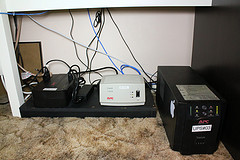Hot on the heels of discussing emergency power for mobile, it is time to discuss thoughts about Uninterruptable Power Supplies(UPS). These battery backup devices use heavy-duty batteries to power your electronics in the event of failure. When power is lost, it automatically powers using the batteries.
The first rule of UPSes is to always get ones with a removable/replaceable battery. You can get replacement batteries without much issue, although manufacturers would obviously prefer you replace the unit.
Our current favorite simple UPS for home use is the APC BE550G. This is an 8 outlet 550VA UPS. The green feature is a master outlet, which turns controlled outlets off when the master device is off. This is also a great green feature for various surge protectors.
<asa>B0019804U8</asa>
However, the basic UPSes may have trouble with some power supplies, so mileage may vary. The issue is voltage regulation, and pure sine waves(necessary for Active PFC power supplies). There are more expensive UPSes, and more full featured ones. There are advantages to voltage regulation and purer power, but for some devices, it doesn’t matter.
Also, there are some issues with APC. We had used Belkin for a while, but had longevity and design issues. The Belkins we had tended to put the outlets on the top, which made placement difficult. There is also Cyberpower, which some people enjoy, but we’ve never tried one. We may next time.
<asa>B000OTEZ5</asa>
This Cyberpower Unit looks promises, offering an LCD control screen with basic stats. This looks rather promising for non-computer uses.
These devices were originally marketed for computers. They were designed for safe shutdown of a computer and monitor, and things have changed. More people are using these to power other devices. In preparing for this post, we started reading reviews, and people are powering big screen TVs and other devices.
So, that is the sort of planning we want to discuss. For your cable modem, your router, etc. We have a simple 300VA UPS hooked up to our cordless telephone system, so it will work for a while in a power outage. As these devices are much lower power than a computer, many can run for hours with just a few necessary networking components hooked in.
The first step, even if you do not want to get into the wattage details, is to make an inventory of the devices you want to power. Make separate lists for extended outages, power hiccups, and voltage drops. Basically, most computers you may want to merely make a graceful shutdown, but you may want your networking gear to last for hours.
We predict, in our area, lots of people will be hiring electricians to install transfer switches for portable or permanent generators, after extended periods of power loss. But for the installation of a manual transfer switch will be close to a thousand dollars, if not more, as it requires disconnecting your house power in order to install the cutoff, and probably an adjustment of your house breaker box.
If your area isn’t prone to long power outages, you want to cover a few hours of power outage or irregular power, which is much less expensive than generators.
In the end, always buy UPSes with replaceable batteries, pick the devices that works for you, and do the advance planning.
What are your tips for planning for power loss with UPSes?
Related articles
 Get the Most Out of Your Generator by Hooking It To a UPS By Eric Limer When the power goes out,…(updates.gizmodo.com)
Get the Most Out of Your Generator by Hooking It To a UPS By Eric Limer When the power goes out,…(updates.gizmodo.com)
 Online during a power outage with the following equipment #sandy(adafruit.com)
Online during a power outage with the following equipment #sandy(adafruit.com)
 Tips for weathering a power outage(newsnet5.com)
Tips for weathering a power outage(newsnet5.com)


